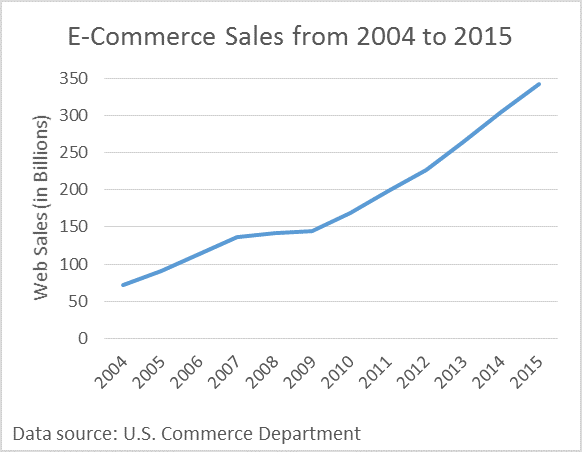When you need a book, you no longer jump in a car and drive to a bookstore. Instead, with just a few clicks on the computer, your book will be waiting at your front door in two days or instantly online. E-Commerce has become a natural and regular part of people’s lives as they buy and sell products and services.
According to the recent U.S. Commerce Department report on Retail Sales, E-Commerce sales in 2015 were estimated at $341.7 billion, a 14.6% increase from 2014. This growth is not an anomaly, but is part of a trend that began in the early 2000s. This surge in E-Commerce sales is driven by avid online shoppers: in 2015, over two third of Americans that have internet access shop online at least once a month, and over a third of them shop online weekly, which is a 9% increase from the previous year. As the non-profit sector faces financial instability with a decline in government funding, it is important to look for new revenue sources to support organizations. The rapid growth of online shopping and its profitable potential has enticed many non-profits to consider including E-Commerce in their digital strategies.
What exactly is E-Commerce? E-commerce is a type of business model that enables an organization or individual to trade tangible and intangible goods or services through electronic channels, primarily the internet. This business model was first introduced in the mid-1980s with services like the Electronic Mall, where users can buy items directly from multiple online merchants. In the 1990s, technological advancements and increasing internet access allowed E-Commerce to gain traction among online sellers and buyers. For-profit enterprises were the first to adopt this new way of conducting transactions, and brands started to spread their reach into regions where they previously had no physical presence for customer development. E-Commerce is a convenient service that operates 24 hours every day and provides a selection of offerings wider than that which a physical store can hold. In simple terms, E-Commerce offers expansive accessibility on an international scale.
The non-profit sector first adopted the E-commerce model as an online donation tool to expand ways of soliciting contributions. Based on a study done by the Chronicles of Philanthropy in 2012, online donations are growing faster than any other type of donation methods including direct mail and telemarketing. Even though online donations only make up an average of 2.1% of all donations from private sources for larger nonprofits, this data demonstrates that people are starting to embrace online transactions. The digital world has become an essential territory for non-profits to enhance constituent experiences; according to “The Next Generation of American Giving” report, between 2010 and 2013, 39% of respondents contributed via online donation and 40% of them contributed by buying products or services through an E-Commerce channel .
In addition to these online donation functions, non-profit organizations with physical stores, primarily museums, have started launching E-Commerce with their existing inventory and merchandise — the Met Store launched its online store in 1999. An interesting 2011 website usability study by the Nielsen Norman Group compared online donation and purchasing processes, revealing that people are more accustomed to spending money on services or products than giving it away. The tested users took 7% more time on average to complete an online donation process than a checkout process. This study reinforced the viability of establishing E-Commerce stores in addition to online donation functions for non-profit organizations. Another reason to expand into digital services like E-commerce is the continued growth in online transactions with a 7.4% increase in retail E-Commerce sales and 9.2% increase in online giving in 2015 compared to the previous year. As the world grows more dependent on the Internet, it is getting easier for people to support non-profits through online donations and purchases.
With expanding online markets and increased proceeds from E-Commerce, setting up an online store has made the to-do list of many non-profits. However, before any organization decides to invest in an E-Commerce platform, there are several fundamental questions that need to be answered. A museum store is different from a gift shop because it aims to reinforce the museum’s educational purposes while generating the greatest possible returns and enhancing visitor experience for good publicity of the museum. This principle also applies to all non-profits that wish to set up an E-Commerce store. Ask yourself, what are your organizational goals with E-Commerce? Are you using it to offer services to your constituents or is it an expansion for earned revenue sources? Depending on your answer, your online store might be structured differently to fit the organization’s mission and goals. In the next research update, we will take a closer look into the decision making process for E-Commerce implementation.
Additional references:
- Hampsey, Casey. Saturday Stats: Online and E-Commerce Channels for Nonprofit Giving | Thedma.org. Thedma.org. June 07, 2014. Accessed February 15, 2016. http://thedma.org/blog/data-driven-marketing/saturday-stats-online-and-e-commerce-channels-for-nonprofit-giving/.
- MacLaughlin, Steve. Charitable Giving Report: How Nonprofit Fundraising Performed in 2015. Blackbaud. February 2016. Accessed February 15, 2016.
- Theobald, Mary Miley. Museum Store Management. Nashville, TN: American Association for State and Local History, 1991.
Banner image by 401(K) 2012, licensed under Creative Commons via Wikimedia Commons.



